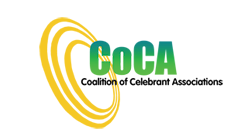SMEG: Suggested Approach to Assessment and Evidence Requirements for Selected Celebrancy Units of Competency –
CHCCEL003 Research, design and organise ceremoniesSuggested assessment activities:
· identified the range and purpose of symbolic elements used in ceremony
· researched and documented the structure, purpose of the ceremony, ceremonial components, common ceremonial elements and symbols appropriate to the following ceremonies: Christenings/ Namings; Coming of Age; Marriage; Wedding Anniversaries; Birthdays; Funerals
· researched and selected at least 10 different examples of music, poetry and prose to meet identified client needs and preferences for each of the following types of ceremony:
- love
- life
- loss
- sight
- sound
- smell
- taste
- movement
- touch
· created at least two (2) different ceremonial senses (visual, auditory and touch) to meet identified client needs and preferences for one ceremony from each of the three (3) following groupings:
- wedding, civil union/commitment or wedding anniversary
- a christening, a baby blessing/ naming or Grandparents Day
- a pet funeral, “living wake”(pre-death ceremony) and community memorial
· created at least two (2) different ceremonial elements related to each of the following senses (smell, taste and movement) to meet identified client needs and preferences for one ceremony from each of the three (3) following groupings:
- betrothal or engagement or renewal of vows
- coming of age or senior birthday or Neighbour Day ceremony
- funeral, an ANZAC Day/ Remembrance Day, memorial for a stillborn child
· created six (6) different examples, including at least one each from the three main types of ceremonies (love, life and loss) for each of the following components of the ceremony structure:
- the entrance
- the warm-up (and group bonding)
- welcome
- introduction (including statement of purpose)
- legalities if relevant
- story-telling/ reflection
- life coaching/ inspiration
- heightening the “gap/ transition”
- the speaking one’s truth
- the promises/commitments (vows) - explicit or implicit
- capturing of memories
- preparation for the next stage
- group affirmation and support
- announcements i.e. after-ceremony requirements, refreshments
- conclusion
- the exit
and described the potential clients (individual, couple, family, group or community) for whom the ceremonial component could be appropriate
· interviewed three (3) people aged approximately 30, 50, and 70 years and “This is Your Life” style Birthday celebration or Funeral Ceremony noting
- the objectives were in preparing the biography
- the couple’s initial and final feedback on the proposed biography, and
- how the conducting of this assignment met the celebrant’s legal, ethical, privacy and other responsibilities
· in preparation for designing for the following ceremonies
- a coming of adolescence ceremony for a young man
- a ‘bon voyage’ ceremony for a young woman who recently graduated from her tertiary studies
- a Valentine Day Proposal ceremony
- a Commitment ceremony
- a 30th wedding anniversary
- a birthday ceremony for a 65 year old male
- a downsizing ceremony (couple leaving the large family home after 40 years to enter a retirement unit)
- a carer graduation ceremony (i.e. someone who stops full-time care of another person after a considerable period of time)
has analysed and documented responses to the question below which follow the first principles for ceremony design:
- What is the occasion?
- Who is the client?
- What are the significant changes from a physical, emotional /psychological, social and cultural point of view that are likely for the client; the client's immediate family; the client's wider family and friends; support network or other appropriate networks?
- From a rite of passage point of view:
- What are the major aims of the ceremony?
- What are the main psychological or spiritual messages the celebrant needs to ensure are conveyed?
- What traditional ceremonies would be the ones to closest in aims?
- Are there any religious or historical parallels?
- In what way would this be the same as a similar ceremony?
- In what way would this be different from a similar ceremony? - How can the client, family and others be involved in the ceremony?
- What suggestions do all the possible participants have for the ceremony or occasion?
- What resources are available in the way of music, poetry, prose, images, DVDs, flowers, donations etc., including what can be found by research the internet, the local library, special interest groups
- What symbols could be appropriate?
- Where could it be appropriate to hold the ceremony, reception, both?
- What other ceremony design, resources, limitations, and other points need to be considered - own limits as celebrants; age, culture, strength of the group; format: structured and mostly formally scripted OR structured but not formally scripted (e.g. circle ceremony); equipment; seating; choreography; props; constraints; venue; WHS issues; timing; draft ceremony approval; certificates another mementos; rehearsal; final plan; PR opportunities
- What follow-up strategies could be used?
- How can the ceremony/celebration be reviewed and used for ongoing improvement in ceremony design and organisation?
· created and organised three (3) ceremonies - one each for a commitment; a 30th birthday; a service in a small community to acknowledge loss, encourage support and show appreciation for the work of volunteers and others in a natural disaster; including:
- preparing written information including letters responding to a client enquiry, a brochure and a web page
- providing written advice to clients and potential clients on the purpose of ceremony and ritual
- explaining the role of the client and celebrant in the development and delivery of the ceremony
- explaining the personal, social, cultural and legal significance of transitions and the role of ceremony in addressing these life changes
- identifying the people and resources required as well as possible problems and following up to ensure effective delivery of the ceremony
- organising the practical aspects of pre-ceremony delivery, delivery of the ceremony, follow-up and review
• created and documented in full each of the following types of ceremony in response to identified client needs and preferences:
- A family-based coming of age ceremony for an 18
- A memorial or placing of the ashes ceremony for a 55 year old adult with intellectual disabilities who died a month before - with the participants being family and family friends, caseworkers and other adults with disabilities from where the adult had supervised employment
- A community-based Mother’s Day or Father’s Day Appreciation Ceremony to celebrate the role of women or men in the community
and documented
o whether the person or persons chosen to be honoured and/or celebrated was male or female
o the different strategies that could have been used to approach the ceremony if the person or persons were the alternate gender
o their verbal explanations to at least three (3) possible role-playing or genuine client/s, from diverse backgrounds, the purpose and associated props for the ceremonial components, elements and symbols in the context of the purpose of the ceremony, readings, quotes, illustrative material etc.


